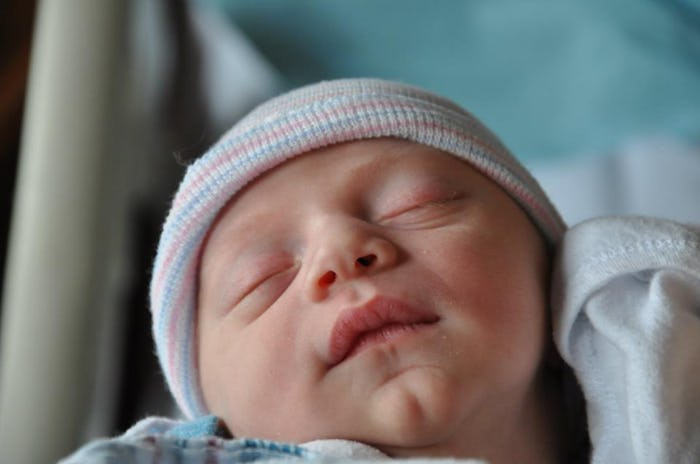Life

Here's Why Your Baby Sleeps Better On You, According To An Expert
I'll paint a picture most parents can relate to: Your baby is inconsolable. You've changed, fed, and burped them, but nothing is working. So you rock them and eventually they fall asleep in your arms, their tiny head on your chest. You let them be for a few minutes, just to make sure they're really asleep, before you set them down in their crib. And what happens? They wake up instantly. Why?! Why does my baby sleep better on me? Because while I love the baby snuggles, I can't live my life trapped under a tiny infant.
Romper spoke to Courtney Marie Long, International Certified Newborn Care Specialist and certified pediatric sleep coach, to learn more.
It turns out the reason your baby sleeps so much better on you than in their crib isn't a huge mystery. "Parents arms are warm and cozy!" Long says. I mean, duh, right? But there's a bit more to it than that. "Babies like and respond better to what they’re used to, and tend to be held very much early on when parents aren’t sure of what other soothing methods may work."
In other words, the way you sooth your baby when they're awake is the way they get used to being soothed in general. Unfortunately, sleeping on you isn't particularly sustainable, as any sleep deprived parent who's tried it will probably tell you. (Who can get a decent night's sleep holding a baby?) Moreover, it's just not safe.
In its official guidelines, the American Academy of Pediatrics (AAP) recommends that while parents should share a room with their child for the first six months, but should not share a sleep surface, especially not an armchair, couch, or sofa. (And let's be honest, that's likely where you'll be when your baby falls asleep on you.) The AAP data is clear: sofas and armchairs may be comfy places to snuggle, but as a sleeping surface they pose an “extraordinarily high risk of infant death.”
"As an advocate for safe sleep, I would suggest never allowing baby to sleep on you, but at night especially," Long tells Romper. "It’s too easy to fall asleep in a dark room, in the middle of the night, snuggling a baby, and can lead to unplanned bed-sharing."
"Safe sleep guidelines don't have a grey area."
Even though your loving arms are often a surefire way for your baby (and, in turn, you) to get to sleep, it's just not advisable. The good news, however, is that by handling this issue now, your baby is on their way to learning to self-soothing skills they'll need to be champion sleepers moving forward. The trick, Long says, is to encourage the same kind of sleep during the day, when you're more awake and alert than you are at night, and so the baby gets used to these sleeping arrangements.
"For day time sleep, I encourage placing baby in the place you want them to sleep (crib or bassinet) as often as possible," Long suggests. "Day time snuggles will happen, but we can’t hold baby all day and expect them to sleep in their crib at night. I would encourage moving away from any nap holding by the 10-week-mark, with the hope that it’s been reduced over time by then."
One way that may help recreate the comfort of sleeping in a parents arms, Long suggests, is swaddling. "Swaddling is safe until baby learns to roll and helps to mimic that snug sensation they had in the womb."
Now if you're like me, you're probably thinking, "OK, but when is it, like, all right to let my baby sleep on me?" Long recognizes that most parents are going to do this at some point, but cautions that the safest option is to place baby on a firm, flat, sleep surface — by themselves — every time they go to sleep.
"Safe sleep guidelines don't have a grey area."
This article was originally published on